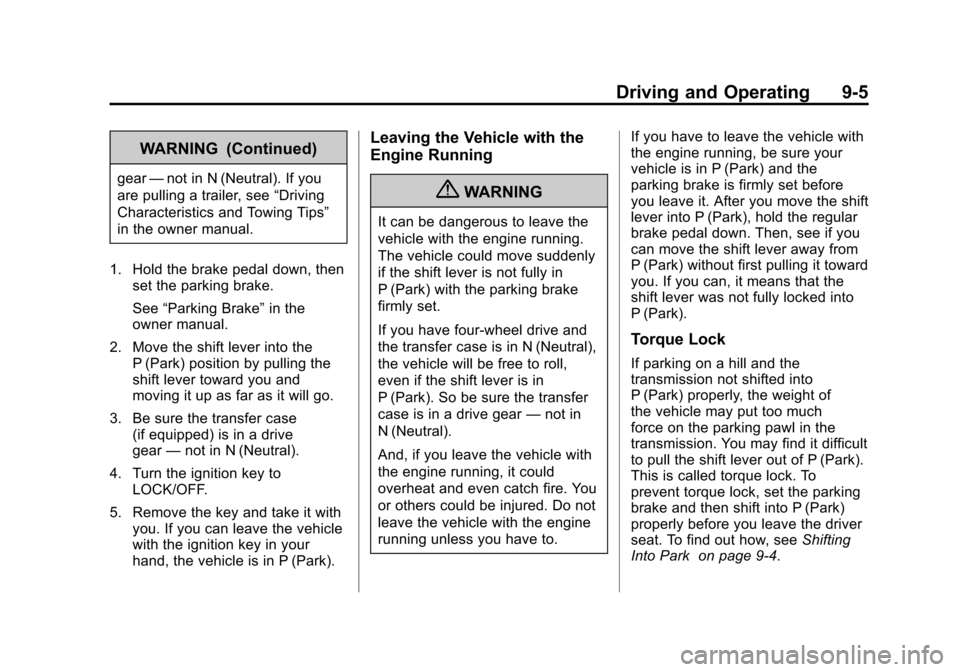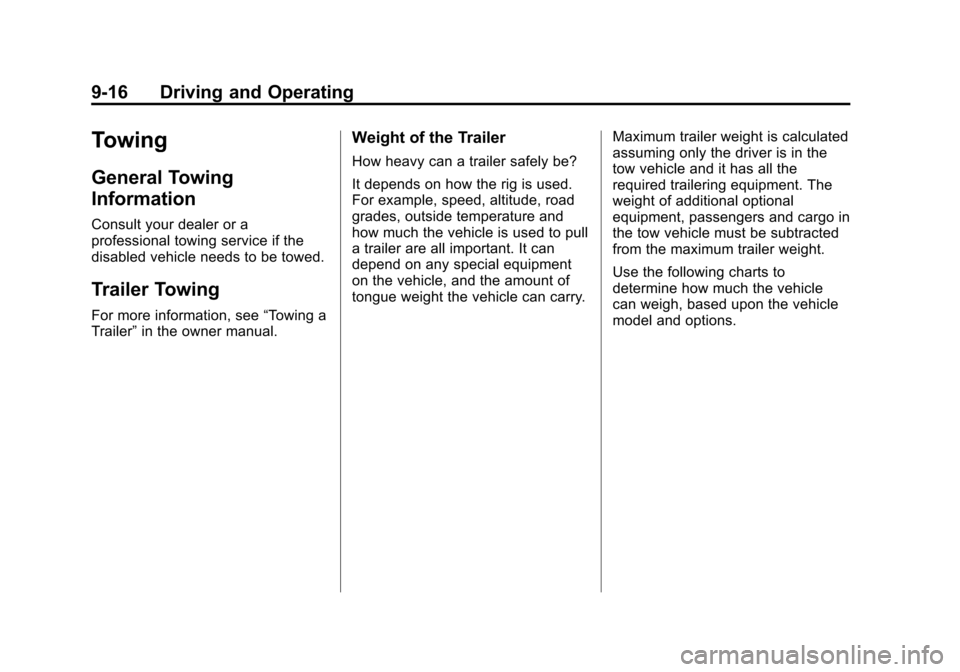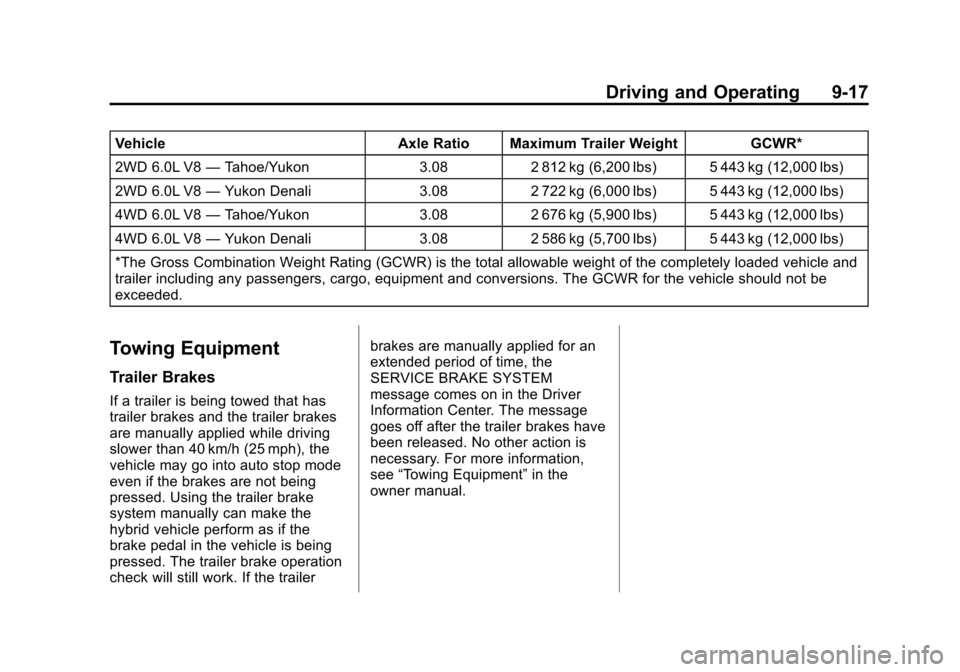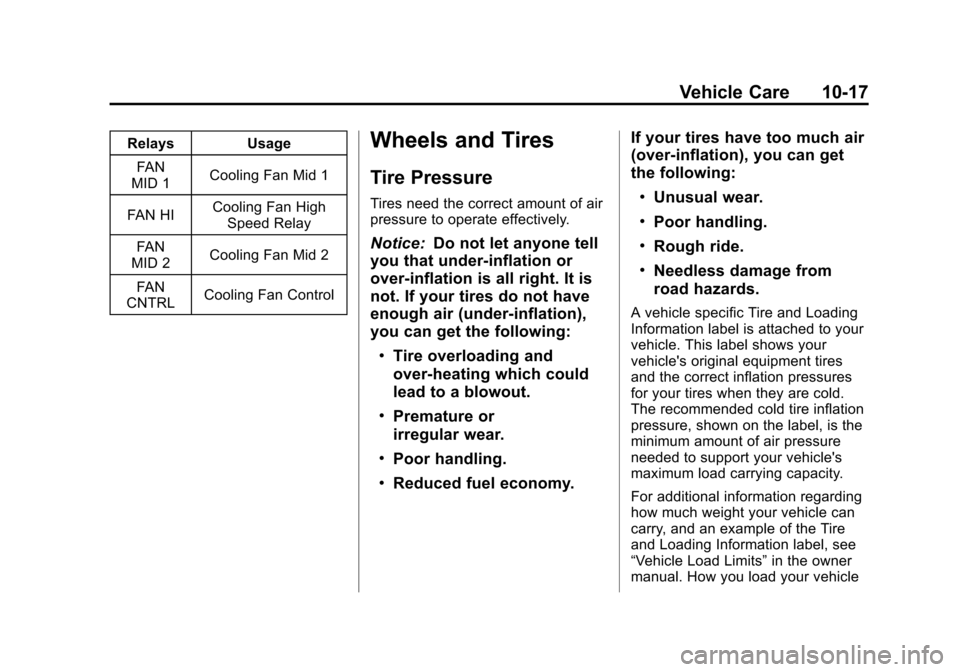weight CHEVROLET TAHOE 2011 3.G Owners Manual
[x] Cancel search | Manufacturer: CHEVROLET, Model Year: 2011, Model line: TAHOE, Model: CHEVROLET TAHOE 2011 3.GPages: 98, PDF Size: 1.55 MB
Page 35 of 98

Black plate (5,1)Chevrolet Tahoe and GMC Yukon/Yukon Denali Hybrid - 2011
Driving and Operating 9-5
WARNING (Continued)
gear—not in N (Neutral). If you
are pulling a trailer, see “Driving
Characteristics and Towing Tips”
in the owner manual.
1. Hold the brake pedal down, then set the parking brake.
See “Parking Brake” in the
owner manual.
2. Move the shift lever into the P (Park) position by pulling the
shift lever toward you and
moving it up as far as it will go.
3. Be sure the transfer case (if equipped) is in a drive
gear —not in N (Neutral).
4. Turn the ignition key to LOCK/OFF.
5. Remove the key and take it with you. If you can leave the vehicle
with the ignition key in your
hand, the vehicle is in P (Park).
Leaving the Vehicle with the
Engine Running
{WARNING
It can be dangerous to leave the
vehicle with the engine running.
The vehicle could move suddenly
if the shift lever is not fully in
P (Park) with the parking brake
firmly set.
If you have four-wheel drive and
the transfer case is in N (Neutral),
the vehicle will be free to roll,
even if the shift lever is in
P (Park). So be sure the transfer
case is in a drive gear —not in
N (Neutral).
And, if you leave the vehicle with
the engine running, it could
overheat and even catch fire. You
or others could be injured. Do not
leave the vehicle with the engine
running unless you have to. If you have to leave the vehicle with
the engine running, be sure your
vehicle is in P (Park) and the
parking brake is firmly set before
you leave it. After you move the shift
lever into P (Park), hold the regular
brake pedal down. Then, see if you
can move the shift lever away from
P (Park) without first pulling it toward
you. If you can, it means that the
shift lever was not fully locked into
P (Park).
Torque Lock
If parking on a hill and the
transmission not shifted into
P (Park) properly, the weight of
the vehicle may put too much
force on the parking pawl in the
transmission. You may find it difficult
to pull the shift lever out of P (Park).
This is called torque lock. To
prevent torque lock, set the parking
brake and then shift into P (Park)
properly before you leave the driver
seat. To find out how, see
Shifting
Into Park on page 9‑4.
Page 46 of 98

Black plate (16,1)Chevrolet Tahoe and GMC Yukon/Yukon Denali Hybrid - 2011
9-16 Driving and Operating
Towing
General Towing
Information
Consult your dealer or a
professional towing service if the
disabled vehicle needs to be towed.
Trailer Towing
For more information, see“Towing a
Trailer” in the owner manual.
Weight of the Trailer
How heavy can a trailer safely be?
It depends on how the rig is used.
For example, speed, altitude, road
grades, outside temperature and
how much the vehicle is used to pull
a trailer are all important. It can
depend on any special equipment
on the vehicle, and the amount of
tongue weight the vehicle can carry. Maximum trailer weight is calculated
assuming only the driver is in the
tow vehicle and it has all the
required trailering equipment. The
weight of additional optional
equipment, passengers and cargo in
the tow vehicle must be subtracted
from the maximum trailer weight.
Use the following charts to
determine how much the vehicle
can weigh, based upon the vehicle
model and options.
Page 47 of 98

Black plate (17,1)Chevrolet Tahoe and GMC Yukon/Yukon Denali Hybrid - 2011
Driving and Operating 9-17
VehicleAxle Ratio Maximum Trailer Weight GCWR*
2WD 6.0L V8 —Tahoe/Yukon 3.082 812 kg (6,200 lbs) 5 443 kg (12,000 lbs)
2WD 6.0L V8 —Yukon Denali 3.082 722 kg (6,000 lbs) 5 443 kg (12,000 lbs)
4WD 6.0L V8 —Tahoe/Yukon 3.082 676 kg (5,900 lbs) 5 443 kg (12,000 lbs)
4WD 6.0L V8 —Yukon Denali 3.082 586 kg (5,700 lbs) 5 443 kg (12,000 lbs)
*The Gross Combination Weight Rating (GCWR) is the total allowable weight of the completely loaded vehicle and
trailer including any passengers, cargo, equipment and conversions. The GCWR for the vehicle should not be
exceeded.
Towing Equipment
Trailer Brakes
If a trailer is being towed that has
trailer brakes and the trailer brakes
are manually applied while driving
slower than 40 km/h (25 mph), the
vehicle may go into auto stop mode
even if the brakes are not being
pressed. Using the trailer brake
system manually can make the
hybrid vehicle perform as if the
brake pedal in the vehicle is being
pressed. The trailer brake operation
check will still work. If the trailer brakes are manually applied for an
extended period of time, the
SERVICE BRAKE SYSTEM
message comes on in the Driver
Information Center. The message
goes off after the trailer brakes have
been released. No other action is
necessary. For more information,
see
“Towing Equipment” in the
owner manual.
Page 65 of 98

Black plate (17,1)Chevrolet Tahoe and GMC Yukon/Yukon Denali Hybrid - 2011
Vehicle Care 10-17
RelaysUsage
FAN
MID 1 Cooling Fan Mid 1
FAN HI Cooling Fan High
Speed Relay
FAN
MID 2 Cooling Fan Mid 2
FAN
CNTRL Cooling Fan ControlWheels and Tires
Tire Pressure
Tires need the correct amount of air
pressure to operate effectively.
Notice:
Do not let anyone tell
you that under‐inflation or
over‐inflation is all right. It is
not. If your tires do not have
enough air (under‐inflation),
you can get the following:
.Tire overloading and
over-heating which could
lead to a blowout.
.Premature or
irregular wear.
.Poor handling.
.Reduced fuel economy. If your tires have too much air
(over‐inflation), you can get
the following:
.Unusual wear.
.Poor handling.
.Rough ride.
.Needless damage from
road hazards.
A vehicle specific Tire and Loading
Information label is attached to your
vehicle. This label shows your
vehicle's original equipment tires
and the correct inflation pressures
for your tires when they are cold.
The recommended cold tire inflation
pressure, shown on the label, is the
minimum amount of air pressure
needed to support your vehicle's
maximum load carrying capacity.
For additional information regarding
how much weight your vehicle can
carry, and an example of the Tire
and Loading Information label, see
“Vehicle Load Limits”
in the owner
manual. How you load your vehicle
Page 66 of 98

Black plate (18,1)Chevrolet Tahoe and GMC Yukon/Yukon Denali Hybrid - 2011
10-18 Vehicle Care
affects vehicle handling and ride
comfort. Never load your vehicle
with more weight than it was
designed to carry.
When to Check
Check your tires once a month
or more.
How to Check
Use a good quality pocket-type
gauge to check tire pressure. You
cannot tell if your tires are properly
inflated simply by looking at them.
Radial tires may look properly
inflated even when they're
underinflated. Check the tire's
inflation pressure when the tires are
cold. Cold means your vehicle has
been sitting for at least three hours
or driven no more than 1.6 km
(1 mile).
Remove the valve cap from the tire
valve stem. Press the tire gauge
firmly onto the valve to get a
pressure measurement. If the cold
tire inflation pressure matches the
recommended pressure on the tireand loading information label, no
further adjustment is necessary.
If the pressure is low, add air until
you reach the recommended
amount.
If you overfill the tire, release air by
pushing on the metal stem in the
center of the tire valve. Recheck the
tire pressure with the tire gauge.
Be sure to put the valve caps back
on the valve stems. They help
prevent leaks by keeping out dirt
and moisture.
Tire Pressure Monitor
Operation
This vehicle may have a Tire
Pressure Monitor System (TPMS).
The TPMS is designed to warn the
driver when a low tire pressure
condition exists. TPMS sensors are
mounted onto each tire and wheel
assembly. The TPMS sensors
monitor the air pressure in the
vehicle's tires and transmit the tire
pressure readings to a receiver
located in the vehicle.
When a low tire pressure condition
is detected, the TPMS will illuminate
the low tire pressure warning
symbol located on the instrument
panel cluster. If the warning light
comes on, stop as soon as possible
and inflate the tires to the
recommended pressure shown on
the tire loading information label.
See
“Vehicle Load Limits” in the
owner manual for more information.
At the same time a message to
check the pressure in a specific tire
appears on the Driver Information
Center (DIC) display. The low tire
pressure warning light and the DIC
warning message come on at each
ignition cycle until the tires are